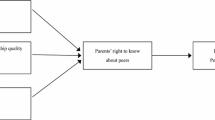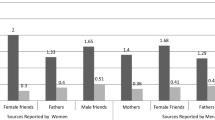Abstract
The purpose of this study is to explore relationships among sex, target, and aspects of adolescent self-disclosure. An adaptation of the Journal and Lasakow (1958) Self-Disclosure Questionnaire (SDQ) was administered to 97 secondary school volunteers with same-sex friend and opposite-sex friend as specified targets. SDQ scores were obtained for a stratified random sample of 30 Ss matched with volunteers for school, grade, age, and sex. Results indicated no sex differences in total disclosure; Ss disclosed differentially to same-sex and opposite-sex friend. Female same-sex disclosure was greater than male same-sex disclosure. A high disclosure cluster for females was Tastes and Interests and Personality; for males it was Tastes and Interests, Work (Studies), and Attitudes and Opinions. These findings reflect patterns for volunteers and nonvolunteers, suggesting that volunteering was not a factor in obtained outcomes. Sex differences in aspects of disclosure are discussed in terms of sex-role variations in establishment of ego identity.
Similar content being viewed by others
References
Blishen, B. R. (1959). The construction and use of an occupational class scale.Can. J. Econ. Pol. Sci. 4: 519–525.
Blos, P. (1962).On Adolescence: A Psychoanalytic Interpretation, Free Press, New York.
Crowne, D. P., and Marlowe, D. (1964).The Approval Motive: Studies in Evaluative Dependence, Wiley, New York.
Doster, J. A., and Strickland, B. R. (1969). Perceived child-rearing practices and selfdisclosure patterns.J. Consult. Psychol. 33: 382.
Douvan, E., and Adelson, J. (1966).Adolescent Experience, Wiley, New York.
Dreyfus, E. A. (1967). Opennes: An examination and formulation.J. Existentialism 7: 309–317.
Erikson, E. H. (1968).Identity: Youth and Crisis, Norton, New York.
Fromm, E. (1947).Man for Himself, Rinehart, New York.
Halverson, C. F., and Shore, R. E. (1969). Self-disclosure and interpersonal functioning.J. Consult. Clin. Psychol. 33(2): 213–217.
Havighurst, R. J. (1958).Developmental Tasks and Education, Longmans Green, New York.
Horney, K. (1950).Neurosis and Human Growth, Norton, New York.
Jourard, S. M. (1958). A study of self-disclosure.Sci. Am. 198(5): 77–82.
Jourard, S. M. (1961a). Self-disclosure patterns in British and American college females.J. Soc. Psychol. 54: 315–320.
Jourard, S. M. (1961b). Age trends in self-disclosure.Merrill-Palmer Quart. Behav. Develop. 7: 191–197.
Jourard, S. M. (1971).The Transparent Self, Van Nostrand, Princeton, N.J.
Jourard, S. M., and Landsman, M. J. (1960). Cognition, cathexis, and the “dyadic effect” in men's self-disclosing behaviour.Merrill-Palmer Quart. J. Behav. Develop. 6: 178–186.
Jourard, S. M., and Lasakow, P. (1958). Some factors in self-disclosure.J. Abnorm. Soc. Psychol. 56: 91–98.
Jourard, S. M., and Richman, P. (1963). Disclosure output and input in college students.Merrill-Palmer Quart. Behav. Develop. 9: 141–148.
May, R. (1967). Contributions to existential psychology. In May, R. (ed.),Existence: A New Dimension in Psychiatry and Psychology, Clarion, New York, pp. 37–91.
Melikian, L. H. (1962). Self-disclosure among university students in the Middle-East.J. Soc. Psychol. 57: 257–263.
Mullaney, A. J. (1964). Relationships among self-disclosure behavior, personality and family interaction.Diss. Abst. 24: 4290.
Pederson, D. M., and Higbee, K. L. (1969). Personality correlates of self-disclosure.J. Soc. Psychol. 78: 81–89.
Rickers-Ovsiankina, M. A. (1956). Social assessbility in three age groups.Psychol. Rep. 2: 283–294.
Rickers-Ovsiankina, M. A., and Kusmin, A. (1958). Individual differences in social assessibility.Psychol. Rep. 4: 391–406.
Riesman, D. (1950).The Lonely Crowd, Yale University Press, New Haven, Conn.
Rivenbark, W. H. (1967). Self-disclosure patterns and sociometric choice in the adolescent period (doctoral dissertation, University of Florida), University Microfilms, No. 67-13157 Ann Arbor, Mich.
Rivenbark, W. H. (1971). Self-disclosure patterns among adolescents.Psychol. Rep. 28: 35–42.
Rogers, C. R. (1951).Client-Centered Therapy, Houghton Mifflin, Boston.
Shapiro, A., and Swensen, C. (1969). Patterns of self-disclosure among married couples.J. Couns. Psychol. 16: 179–180.
Sullivan, H. S. (1947).Conceptions of Modern Psychiatry, William Allison White Foundation.
West, L. W. (1968). Patterns of self-disclosure for a sample of adolescents and the relationship of disclosure style to anxiety. Unpublished Ph.D. thesis, University of Alberta.
West, L. W. (1970a). Sex differences in the exercise of circumspection in self-disclosure among adolescents.Psychol. Rep. 26: 226.
West, L. W. (1970b). Some implications of self-disclosure studies for group counselling with adolescents.Can. Couns. 4: 57–62.
West, L. W. (1971). A study of the validity of the self-disclosure inventory for adolescents.Percept. Motor Skills. 33: 91–100.
West, L. W., and Zingle, H. W. (1969). A self-disclosure inventory for adolescents.Psychol. Rep. 24: 439–445.
Winer, B. J. (1962).Statistical Principles in Experimental Design, McGraw-Hill, New York.
Zief, R. M. (1962). Values and self-disclosure, Unpublished honors thesis Harvard University.
Author information
Authors and Affiliations
Additional information
The larger study from which the data under discussion were drawn is entitled “Cognitive Self-Modeling, Conventional Group Counselling and Change in Interpersonal Communication Skills.” Two co-investigators were involved in the study—J. G. Schachter and W. E. Reitz. In addition, research assistance was provided throughout the study by K. H. Hough. A detailed summary of all demographic data is available upon request from the author.
(King's College is affiliated with the University of Western Ontario.) Received Ph.D. from The Institute for Child Study, University of Maryland. Main interests are child development and counseling.
Rights and permissions
About this article
Cite this article
Mulcahy, G.A. Sex differences in patterns of self-disclosure among adolescents: A developmental perspective. J Youth Adolescence 2, 343–356 (1973). https://doi.org/10.1007/BF02213705
Received:
Issue Date:
DOI: https://doi.org/10.1007/BF02213705




